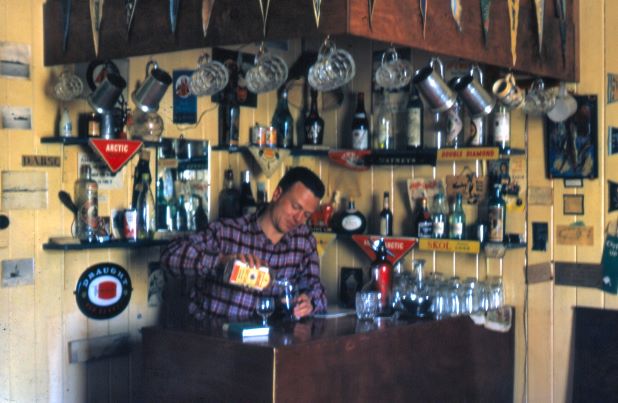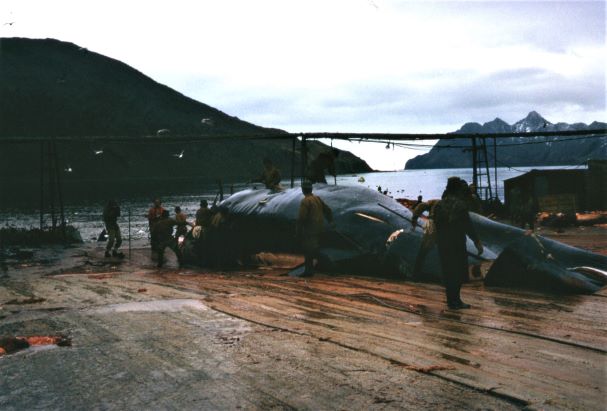A simple way to get to Stonington – Sandy Muir
December 1963! This is the tale of two medical officers’ trip to Marguerite Bay. Mike Rice was going to Adelaide base and I was to go to Stonington. We had been delayed by our research preparations in the MRC unit and were therefore to ship south in a somewhat complicated way. The plan was for us to sail south on a chartered Danish ship, the Kista Dan, which was doing the trip to Halley Bay. We were to meet up with the John Biscoe in South Georgia which was scheduled to relieve Adelaide and Stonington. It did not go quite to plan.

Mike and I were just settling in and meeting up with the Fidlets going to Halley Bay when we added another late-comer to our trip. It was Garrick Grikurov a Russian Geologist who was going to see how our geologists worked and had been assigned to Stonington. Russian!! This was 1963 and joint working with the Soviets just did not happen! However Garrick was a great chap to have around and he had a great sense of humour and provided us with a valuable insight of life in the USSR.
Continuing from Stonington Base Page
Our trip across Biscay was pretty rough. The captain fell and badly sprained his wrist. I had to bind it up. The Captain insisted that I dressed it each day and 8am was the assigned time. However after the treatment was completed I had to down a schnapps with him. This would not have been too bad but I had been made the keeper of our bar and I had a daily meeting with the chief steward to do our ordering. This was accompanied by sampling particularly of Carlsberg Special. Maybe that accounts for somewhat dim memories of the voyage.

Eventually we reached South Georgia by way of Montevideo and Port Stanley. Grytviken was still involved in whaling. There was the terrible sight of huge whales being pulled up on the plan and dissected at an alarming speed. We also learned we were to be transferred to the Shackleton which would take us as far as the John Biscoe which was further south. There the transfer would take place. The voyage was largely uneventful although one night we were shown a film about tug boats during the war. One phrase from a scene struck a chord – “when the Captain laughs everybody laughs”. Our skipper enjoyed that line and repeated it endlessly and was greatly disappointed that this line was not taken up by crew or travellers. After a stop at Signy we arrived at Deception base. Mike, Garrick and I were offloaded to the base. Possibly we were waiting on the John Biscoe but we did learn she was stuck in ice further south.
We were made temporary members of the base and settled in. We were visited by the Captain of a Chilean naval ship who had a cousin who was a very well-known cardiac surgeon in Edinburgh, for whom I had worked 2 years before. This acquaintance served me well for the base leader and I were invited to his ship the Angamos for a very convivial evening. I had an introduction to Pisco Sours. We returned to the base in a small but fast motorboat at 6 am!
Another nautical trip was to be taken for a look around the ocean in the US icebreaker the East Wind. A very smart ship. While we stopped for lunch many of the crew were allowed off ship to enjoy their two cans of beer ration. American ships were alcohol free so that’s why the crew were set loose on an ice flow to enjoy the beer.
Eventually we got a new plan! We were to be picked up by HMS Protector (the Navy’s Ice Patrol ship) and taken to a meeting with the John Biscoe. The Biscoe was still stuck in ice about 30 miles north of Adelaide island. Protector arrived and we boarded to find our accommodation was in a small room directly above the rudder control mechanism and we had to endure two nights of audiological insult there. Apart from this challenge we were well treated. However we were told the transfer was to be by helicopter. We went through a whole series of emergency drills for emergency landings and then boarded the craft. It was a somewhat manky day and visibility was not great. But the Protector had to go north again and there was a need to off load the 3 Marguerite Bay transferees. However the equipment for my measurement of oxygen consumption had a low priority and had to be left behind. At this stage I was not going to argue.
As a flight it was disappointing because of the poor weather. Eventually we did see the Biscoe – a small red blot in a vast and never-ending sea of ice. We landed and were welcomed by the ship’s company. An early task was to anaesthetise a poorly dog with a bone stuck in its guts. Our vet in residence did a superb job of on-ship gut resection.

We were soon inducted in games to free us from the ice. One game involved us trying to dig a space around the bows so that the ship could get some momentum and smash its way out of the impasse. Quite a sight to see 30 or so Fids trying to dig enough ice from around the ship’s bows. The only merit in this attempt was in not losing any one into the ocean.
The biggest help was a wind which tended to loosen the sea ice and allow for some progress. After a few days we were within 3 or 4 miles off the northern tip of Adelaide island. A new plan! A small party of men and dogs led by the experienced John Cunningham were to sledge across the sea ice to land and there they were to meet with a motorized party from Adelaide base. It could have been disastrous but somehow we made it. Later the sea ice started to break up and the Biscoe was able to come in and tie up along the ice cliffs. The next day we were going to effect a transfer of stores to the party from Adelaide but the ice cliff started to fall away and the ocean open up. We quickly departed. We resumed our voyage and sailed down to Adelaide base. After completing the transfer of those bound for Adelaide base including Dr Mike Rice we sailed across to Stonington without a hitch and were given a warm welcome by all on the base.
My transportation from Portsmouth to Stonington had been of 2 ships of BAS provenance and one hired from the Danes. One was of the Royal Navy. They also threw in a helicopter. I had two joy rides -the Angamos and the East Wind. Added to that were four fairly scary miles of frozen sea on foot with dog teams. A simple trip!
Sandy Muir – Medical Officer – Stonington 1964
